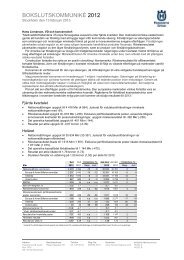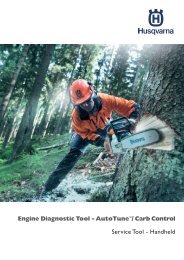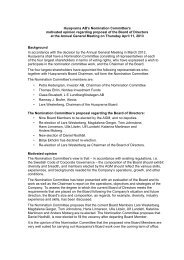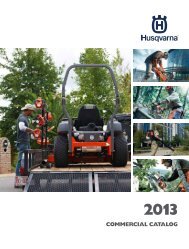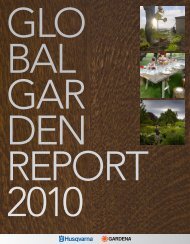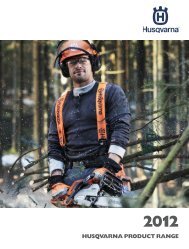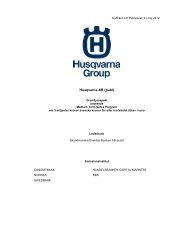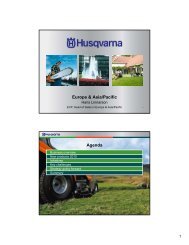Annual Report 2009 - Husqvarna Group
Annual Report 2009 - Husqvarna Group
Annual Report 2009 - Husqvarna Group
You also want an ePaper? Increase the reach of your titles
YUMPU automatically turns print PDFs into web optimized ePapers that Google loves.
56 <strong>Husqvarna</strong> <strong>Annual</strong> <strong>Report</strong> <strong>2009</strong> Notes<br />
Amounts in SEKm unless otherwise stated.<br />
Cont. Note 1<br />
When hedges are entered into the <strong>Group</strong> documents at the<br />
inception of the transaction, the relationship between hedging<br />
instruments and hedged items, as well as the <strong>Group</strong>’s riskmanagement<br />
objectives and strategy for undertaking various<br />
hedging transactions. The <strong>Group</strong> also documents its assessment,<br />
both at the hedging inception and on an ongoing<br />
basis, of whether the derivatives that are used in hedging<br />
transactions are highly effective in offsetting changes in fair<br />
values or cash flows of hedged items.<br />
Fair-value hedge<br />
Changes in the fair value of derivatives that are designated<br />
and which qualify as fair-value hedges are recorded as financial<br />
items in the income statement, along with any changes in<br />
the fair value of the hedged asset or liability that are attributable<br />
to the hedged risk.<br />
If the hedge no longer meets the criteria for hedge<br />
accounting, the adjustment to the carrying amount of a<br />
hedged item for which the effective interest method is used,<br />
is amortized to the income statement over the period of<br />
maturity. Currently there are no fair-value hedges in the<br />
<strong>Group</strong>.<br />
Cash-flow hedge<br />
The effective portion of change in the fair value of derivatives<br />
that are designated and qualify as cash-flow hedges are recognized<br />
in other comprehensive income. The gain or loss<br />
relating to the ineffective portion is recognized immediately<br />
in the income statement as financial items.<br />
Amounts accumulated in equity are reclassified and recognized<br />
in the income statement in the periods in which the<br />
hedged item will affect profit or loss (for instance when the<br />
forecast sale which is hedged takes place). However, when the<br />
forecast transaction that is hedged results in the recognition<br />
of a non-financial item (for example, inventory), the gains and<br />
losses previously deferred in equity are transferred from<br />
equity and included in the initial measurement of the cost of<br />
the asset or liability.<br />
Net investment hedge<br />
Hedges of net investments in foreign operations are treated<br />
similarly to cash-flow hedges. Any gain or loss on the hedging<br />
instrument relating to the effective portion of the hedge is<br />
recognized in other comprehensive income; the gain or loss<br />
relating to the ineffective portion is recognized immediately<br />
in the income statement as financial items.<br />
Gains and losses accumulated in equity are included in the<br />
income statement when the foreign operation is disposed of,<br />
or in the event of a partial disposal.<br />
Derivatives that do not qualify for hedge accounting<br />
Certain derivative instruments do not qualify for hedge<br />
accounting. Changes in the fair value of any derivative instruments<br />
that do not qualify for hedge accounting are recognized<br />
immediately in the income statement as financial items.<br />
Share-based compensation<br />
IFRS 2 is applied for the share-based compensation programs<br />
granted in 2007, 2008 and <strong>2009</strong>. The instruments granted are<br />
shares and options. <strong>Husqvarna</strong> classifies its share-based<br />
compensation programs as equity-settled programs, which<br />
means that the cost of the granted instruments’ fair value at<br />
grant date is recognized over the vesting period. The fair<br />
value of the instruments is the market value at grant date,<br />
adjusted for the discounted value of future dividends which<br />
employees will not receive. At each balance sheet date, the<br />
<strong>Group</strong> revises the estimates of the number of instruments that<br />
are expected to vest. <strong>Husqvarna</strong> recognizes the impact of the<br />
revision to original estimates, if any, in the income statement,<br />
with a corresponding adjustment to equity.<br />
In addition, the <strong>Group</strong> provides for employer contributions<br />
expected to be paid in connection with the share-based compensation<br />
programs. The costs are charged to the income<br />
statement over the vesting period. The provision is periodically<br />
revalued on the basis of the fair value of the instruments<br />
at each closing date.<br />
Cash flow<br />
The cash-flow statement has been prepared according to the<br />
indirect method.<br />
Parent company’s accounting<br />
and valuation principles<br />
The accounting principles described above are applied by the<br />
Parent Company <strong>Husqvarna</strong> AB with only a few exceptions<br />
and additions. <strong>Husqvarna</strong> <strong>Group</strong> applies IAS 19 Employee<br />
Benefits while the Parent Company applies the principles of<br />
FAR’s recommendation No 4 “Accounting of pension liabilities<br />
and pension costs”. The differences are described in<br />
Note 19 Employees and employee benefits.<br />
In addition to the depreciation described above in Property,<br />
Plant and Equipment, the Parent Company reports additional<br />
fiscal depreciation, permitted by Swedish tax law, as<br />
appropriations in the income statement. In the balance sheet,<br />
these are included in untaxed reserves.<br />
Investments in associated companies are reported at<br />
historical cost.<br />
<strong>Group</strong> contributions are reported in accordance with UFR 1<br />
(Swedish Financial <strong>Report</strong>ing Board). <strong>Group</strong> contributions<br />
paid or received to reduce the <strong>Group</strong>’s tax burden are<br />
reported directly against retained earnings, after adjustment<br />
for the current tax.<br />
New accounting principles as from <strong>2009</strong><br />
The IASB has issued standards, interpretations and amendments<br />
to standards applicable for <strong>Husqvarna</strong> as from <strong>2009</strong>.<br />
IAS 1 Presentation of Financial Statements (Revised). The<br />
revised standard prohibits the presentation of items of<br />
income and expenses (that is, “non-owner changes in equity”)<br />
in the statement of changes in equity, requiring “non-owner<br />
changes in equity” to be presented separately from owner<br />
changes in equity. All non-owner changes in equity is required<br />
to be shown in a performance statement, but entities<br />
can choose whether to present one performance statement<br />
(the statement of comprehensive income) or two statements<br />
(the income statement and statement of comprehensive<br />
income). <strong>Husqvarna</strong> uses the second alternative and presents<br />
the income statement and the statement of comprehensive<br />
income separately.



